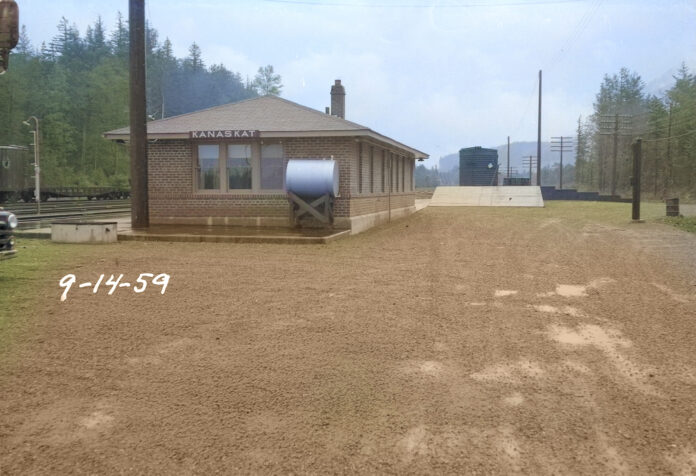In February 1959, the U.S. Army Corps of Engineers began constructing an earthen-fill dam to control the devastating Green River floods that regularly ravaged the broad valley downstream, stretching from Auburn through Kent to Renton. The planned structure was originally called the Eagle Gorge Dam, then renamed by Congress to honor Howard Hanson, a Seattle attorney and state legislator who campaigned for the project. Hanson died in 1957 before construction began.
To complete the Howard Hanson Dam, the Army Corps of Engineers relocated 13 miles of Northern Pacific Railway (N.P.) track, resulting in the building of this fourth Kanaskat rail depot. It was 300 feet to the north and 20 feet topographically higher than the 1946 railway station featured in last week’s column.
The new station opened on June 28, 1959. It was of the same design as the 1946 station but built using a reverse blueprint as it faced tracks in the opposite direction. The four Kanaskat railroad stations were descendants of the original Green River station, one-half mile south, and shortly thereafter renamed Palmer. Kanaskat didn’t get a rail station for over a decade, until a new rail line to Auburn, passing through Ravensdale and Covington was built. However, throughout the long history of the one Palmer and four Kanaskat stations, the telegraph call letters remained GV, an extrapolation from Green riVer.
In 1916, 98% of all commercial travelers between cities moved by rail. Nearly 42 million passengers, over 40% of the U.S. population used railways as their primary mode of transportation. Over the decades, patronage declined as competition from buses, automobiles, and air travel replaced trains. Though rail traffic surged during World War II, aided by troop movements and gasoline rationing, the relief was only temporary.
With advances in interstate highways plus new airports and planes, by the 1960s, train travel plummeted and railroad companies lost huge sums on passenger service. The death knell proved to be a 1967 decision by the Post Office to end its contract with rail carriers for moving the mail on passenger trains. After the 1970 Rail Passenger Service Act created Amtrak, over half of all routes were discontinued. Most railroad companies became freight-only.
The 1970 creation of Burlington Northern (B.N.) from the merger of Northern Pacific, Great Northern, Pacific Coast, Spokane, Portland & Seattle, and the Chicago, Burlington & Quincy railroads created a new Washington state powerhouse, particularly for freight service. It also enabled N.P. traffic that formerly traveled through Kanaskat over Stampede Pass to use a more convenient route – Great Northern’s rails over Stevens Pass.
The 1959 Kanaskat railway station was decommissioned in early 1973. It became the signal repair shop and ‘speeder’ car garage overseen by Neil Marzolf. When the Stampede Rail line that passed through Kanaskat on its way up the Green River to Eastern Washington was mothballed by B.N. in 1983, the old station was ruined by vandals over time. When the line reopened in 1996, what remained of the ramshackle building was demolished.
But in its day, the Kanaskat station was home to local commerce. To the right of the depot is a loading ramp that truckers used to transfer their loads to the boxcar that sits behind it. For years, Boxcar NP23770 served as a ‘way car’ for hauling small freight loads from Kanaskat to Lester for the Scott Paper Company and residents of that railroad town.
But its most frequent use was weekly shipments for Kochevar & Sons, the beer distributor based in Enumclaw. Loads of Rainier beer were shipped to Lester and delivered to the tavern owned by Harold Dumpis, who also worked for N.P. as the signal maintainer, and to the café operated by Joe and Bonnie Nuzum. When the boxcar returned to Kanaskat, it was full of empty bottles, back when there was a penny per bottle return credit. Lester incidentally was originally known as Dean’s Mill and fittingly carried DM as its telegraph call letters.
This photo, one of many from tax parcel 102107-9020, comes courtesy of Puget Sound Regional Archives, which holds the historic King County Assessor records. Photo editing and colorization were performed by Doug ‘Boomer’ Burnham, a Tahoma high school instructor doing business as http://www.boomersphotography.com/
This column is indebted to Dave T. Sprau, a railroad and telegraph man since his teenage days. Sprau was born in Snohomish in 1944 and learned telegraphy while aged 12 to 15, “thanks to the indulgence of employees at the Great Northern Railway station in Monroe, WA.” He joined N.P. in 1960 at age 16 and continued employment in railroad work until retiring in 2000. He was active in union affairs and holds a life membership in the Brotherhood of Locomotive Engineers & Trainmen. Today, he lives in Warren, Oregon, with his wife, Linda (Braden) Sprau.







